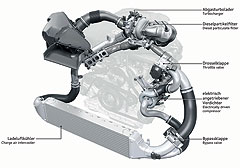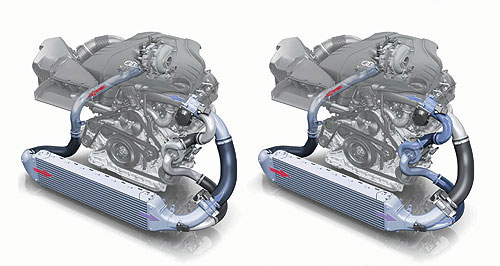News - General News - TechnologyAudi developing electric turboIn a spin: Using energy from regenerative braking, Audi claims its electric turbo can benefit step-off performance without increasing fuel consumption. Electric turbocharger eliminates lag, produces less heat than twin-turbos: Audi21 Sep 2012 AUDI is working on an electric turbocharger driven by energy gleaned from regenerative braking, designed to improve low-speed response from its forced-induction engines by reducing turbo lag. The company has not revealed whether the system has any engine output or fuel consumption benefits but says it achieves “high levels of torque even at low revs... which the driver perceives as a distinct boost in performance”. Audi engineers based at Neckarsulm 60 kilometres north of Stuttgart, used a 3.0-litre V6 turbo-diesel unit to develop and test the system, which uses a small electric motor connected to a turbine and can spin it up to create boost “in an extremely short time”. The electric compressor resembles a conventional exhaust-driven turbo and is attached to the side of the cylinder block, piping pressurised air directly into the engine’s inlet manifold downstream of the main turbocharger and intercooler and is bypassed using a valve in most driving conditions. When the exhaust-driven turbo – nestled between the two banks of cylinders – is operating at low outputs, the electric unit comes back into play and increases the amount of air entering the engine.  Audi says the system yields the benefits of two-stage twin-turbocharging without generating as much heat, meaning the catalytic converter can be activated sooner. Audi says the system yields the benefits of two-stage twin-turbocharging without generating as much heat, meaning the catalytic converter can be activated sooner.It also claims the energy consumed by spinning the electric turbo is “essentially neutral” because the power required is “largely offset by battery regeneration during coasting phases”. Car-makers are becoming increasingly innovative in squeezing every drop of performance and efficiency from internal combustion engines in addition to developing hybrid, electric and alternative fuel systems. For example, in 2005 BMW came up with the Turbosteamer concept that harvested heat generated by an internal combustion engine, turning it into energy that helped drive the crankshaft – yielding a 15 per cent fuel consumption reduction and 10kW more power. Another technology Audi has in development is a satellite navigation-based predictive efficiency assistant (PEA) system that helps the driver save fuel by adopting a predictive, rather than reactive, driving style that involves less braking and more coasting or making the most of momentum when driving on hills. Combined with the company’s next-generation iHEV idle-stop system that also deactivates the engine while freewheeling and uses a 48-volt lithium-ion battery to restart it, Audi found drivers to cover 43 per cent of a test route with the engine off, compared with 28 per cent with PEA deactivated. It is similar to a system BMW has introduced in some markets for its petrol-electric Activehybrid 3 Series, 5 Series and 7 Series models, which use topographical sat-nav data to prime the adaptive cruise control system and ensure the hybrid drivetrain makes the most of electric assistance and regenerative braking during a journey. Audi expects the effectiveness of PEA to be enhanced by improved in-car connectivity that can enable the system to react to live information such as traffic and roadworks updates, plus information from vehicle-to-vehicle and vehicle-to-infrastructure systems. The company has confirmed it will offer at least one electrified variant in each of its vehicle segments by 2020 and will introduce the A6 and A8 hybrid to Australia next year.  Read more21st of September 2012  Paris show: 221kW Audi S3 punches above its weightFast yet frugal Audi S3 hot hatch features new 221kW/380Nm 2.0 turbo four20th of September 2012  Paris show: Audi A3 Sportback sheds kilosNew Audi A3 five-door gets radical changes under its same-again styling17th of September 2012  Sizzling Audi SQ5 headed for OzAudi Australia locks in twin-turbo SQ5 TDI super-SUV for mid-2013 local launch7th of September 2012  Paris show: Audi reveals RS5 CabrioletAudi whips the covers from hardcore RS5 Cabriolet in special online video10th of August 2012  Audi lets rip with revised RS5Updated RS5 coupe storms into Audi Australia showrooms from a sharper $161,400 |
Click to shareGeneral News articlesResearch General News Motor industry news |
















Facebook Twitter Instagram